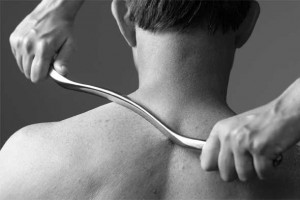Soft tissue mobilization- more than just massage
The “soft tissue” in the body includes muscles, tendons, ligaments, and their protective covering called fascia. When any of these areas are tight, movement can become restricted and painful. The goal of any soft tissue mobilization is to loosen these structures to allow better mobility or muscle activation.
There are many different types of soft tissue mobilizations that physical therapists perform. Some of the more specialized types we perform in our clinic are described below:
Instrument Assisted Soft Tissue Mobilization (IASTM) - is applied using specially designed instruments to provide a mobilizing effect to soft tissue (e.g., scar tissue, myofascial adhesion) to decrease pain and improve range of motion (ROM) and function. The use of the instrument is thought to provide a mechanical advantage for the clinician by allowing deeper penetration and more specific treatment, while also reducing imposed stress on the hands. (Cheatham, 2016)
Active Release Techniques (ART) - ART is a method for treating the soft tissues such as the tendon, nerve, and myofascia, and is performed for repetitive strain injury, acute injury, and functional fixation damage due to abnormal posture maintained over the long term. Furthermore, ART is an effective at resolving adhesion of scar tissue and the soft tissue that causes pain, spasm, muscle weakness, tingling, and other symptoms. (Kim, 2015)
Cupping - Cupping is a myofascial release technique that is used to relieve tension and promote circulation in the body. Mechanically, cupping increases blood circulation, whereas physiologically it activates the immune system and stimulates the mechanosensitive fibers, thus to a reduction in pain. (Rozenfeld, 2016)
-Korey Pieper, DPT, OCS, CCI




